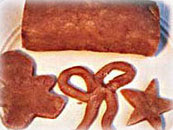If spring fever has left you with a lingering case of wanderlust, we have just the cure. It doesn’t involve a single security check or layover, and you’ll never experience a minute of jet lag. Best of all, at the end of your tour, you and your family will have edible souvenirs!
The travel experience we’re talking about begins and ends in your kitchen. We’ll be journeying around the world through recipes that give us authentic tastes of global cultures. The only baggage you’ll need are measuring cups, baking pans, and—of course!—C&H Pure Cane Sugar, the best in the whole wide world.
The British Isles
“Hearty” and “satisfying” are often used to describe traditional baked goods in England, Scotland, and Ireland. Consider Hot Cross Buns, a very old recipe for rich, eggy yeast buns decorated with a frosting cross. Hot Cross Buns are associated with Good Friday, but probably date back to pagan times. They’re delicious any time of year with brunch or afternoon tea. Speaking of tea, our Tea Leaf Shortbread Cookies take a classic, buttery Scottish shortbread recipe and add loose tea leaves for subtle flavor and flecks of color. Irish Soda Bread, leavened with baking soda and baking powder and made tangy with buttermilk, is a relatively recent tradition: it was invented in the 1840s, when bicarbonate of soda was introduced to Ireland. (Purists say our version should be called “Spotted Dog,” because it includes raisins. And some insist that recipes containing sugar and eggs should be called soda cake, not soda bread.)
No tour of the British Isles is complete without trifle, the luscious layered dessert that combines sponge cake, custard, fruit (or jam), and cream. Strawberry–Kiwi Almond Crunch Trifle is well worth the investment in time: not only is it delicious, it’s a beautiful centerpiece at a party or special dinner.
Western Europe
Madeleines are almost universally associated with France, thanks in large part to the writer Marcel Proust, who summoned up three novels from their haunting aroma. These delicate, shell–shaped cookies are lightly flavored with citrus rind and baked in a special madeleine pan. Crème Brulée is a quintessentially French custard: decadently rich and smooth under a crackling brown–sugar crust. We love it accompanied by crisp tuile cookies. For a more rustic approach, try Cherry Clafouti (say “cla–FOO–tee”) with fresh or frozen cherries; a cross between custard and cake, it’s quick and easy to make, and delicious at any meal—yes, even breakfast!
Hop over to Spain for a taste of Vanilla Caramel Flan, a custard lightened with whipped egg whites and swimming in liquid caramel. In Portugal, sample the Portuguese Sweet Bread (also popular among Portuguese immigrants throughout the United States), a lemon–flavored egg bread that can be shaped into buns, rings, or loaves.
While you’re in Bella Italia, you must of course partake of Panettone, a fruit–filled yeast bread that’s often seen during the Christmas season but in fact is popular year round. Italian Pound Cake gets its name from the presence of cornmeal (or polenta, the Italian version); serve it with fresh fruit and softly whipped cream for a special dessert. Or with Zabaglione; the classic Italian custard that’s flavored with Marsala and nutmeg. You can also spoon it over fruit or crisp cookies like these twice–baked Walnut Cappuccino Biscotti.
Central Europe
Flaky pastries and rich, nut–filled confections… we must be approaching Austria! Celebrate with Apple Strudel, made the time–honored way with a pulled dough that’s tenderized with a bit of cider vinegar. Viennese Crescents remind us that the Islamic Ottoman Empire—whose flag bore the crescent symbol—twice failed to conquer Vienna in the sixteenth and seventeenth centuries. Our version of Rugelach, a rich rolled cookie made with cream–cheese dough, is filled with raspberry jam, currants, and chopped nuts, but you can substitute chopped raisins or chocolate chips, or a different flavor of jam. And no culinary visit to this part of the world would be complete without a taste of Marzipan, the sugar–and–ground–almond confection that’s a specialty of Germany’s Black Sea region (although it probably originated in Persia). Use the basic recipe to make deliciously decorative fruits, flowers, leaves, or other creations.
Middle East and Asia
As we journey east, baked goods become less prominent. One exception is Mamoul, the buttery, pistachio–filled cookies native to Lebanon. Rosewater is the traditional flavoring, but you may substitute orange flower water. Chutney—the word comes from Hindi or Urdu chatni—is the classic sweet–and–spicy condiment of South Asia.
Golden Mango Chutney uses the delicious fruit native to India and Pakistan, along with traditional ginger, garlic, mustard seeds, and chili pepper. You’d likely find Sweet Glutinous Rice on a dessert menu in the South Pacific; coconut milk, vanilla, and C&H Pure Cane Dark Brown Sugar give it an irresistible consistency and flavor.
Down Under
We end our round–the–world trip in Australia and New Zealand, home to the delectable Pavlova With Lemon Sorbet. This light, sweet meringue was named in honor of the Russian ballerina Anna Pavlova, who toured Australia and New Zealand to wild acclaim in 1935. Still hungry? Reach for a moist, sweet Kiwi Guava Muffin, made with guava nectar and pale green kiwifruit, which was first grown commercially in New Zealand and named for that country’s national bird.






No comments:
Post a Comment